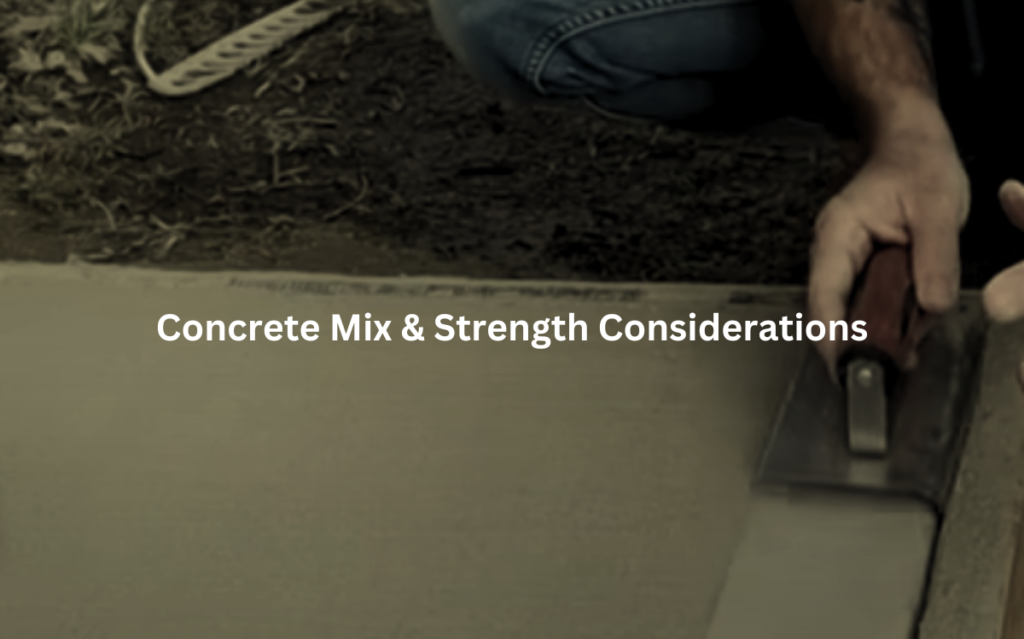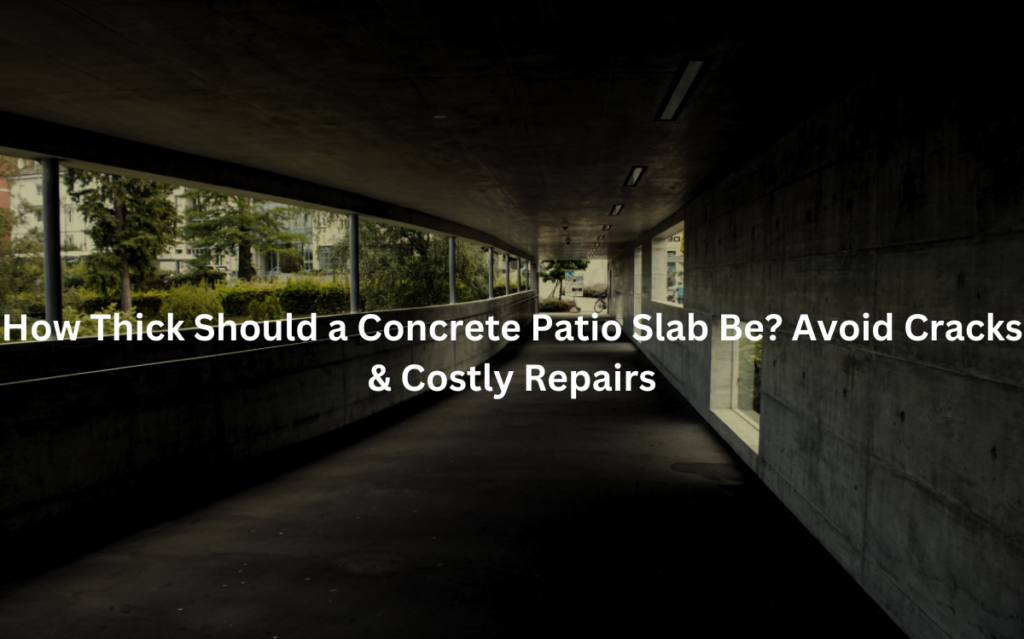Get the right concrete patio slab thickness for durability and strength. Learn how to prevent cracks and costly repairs.
The ideal thickness for a concrete patio slab depends on its use. A 4-inch slab is standard for foot traffic, while 6-8 inches is necessary for heavy loads like hot tubs or outdoor kitchens. (1)
Soil conditions, reinforcement, and proper base preparation also play key roles in durability. Skimping on thickness can lead to cracks, shifting, and costly repairs.
Key Takeaways
- 4 inches is the minimum, but 6-8 inches is better for heavier loads.
- A compacted gravel base (3-6 inches) prevents cracking and settling.
- Rebar or wire mesh reinforcement increases strength and longevity.
Standard Concrete Patio Slab Thickness
Credits: Deco-Crete TV
A concrete patio slab needs the right thickness to support weight, resist cracking, and hold up over time. Too thin, and it breaks under pressure. Too thick, and it’s just wasted material. Most residential patios use a 4-inch slab, but the intended use dictates whether more is needed.
- 4-inch slab – Works for foot traffic, patio furniture, and standard use.
- 6-inch slab – Better for outdoor kitchens, fire pits, and moderate loads.
- 8-inch slab – Necessary for hot tubs, driveways, and commercial patios.
- Thickened edges (turndown beam) – A 6-inch deep edge prevents stress cracks.
Soil conditions matter, too. Soft or expansive soil may require a thicker slab or a stronger base. Reinforcement—whether rebar or wire mesh—adds structural integrity, but it doesn’t replace proper slab thickness. Skimping on thickness might save money upfront, but it leads to costly repairs down the line.
Load Capacity & Intended Use
Concrete thickness is a make-or-break factor. Go too thin, and cracks or sinking happen fast. Go too thick, and it’s wasted material. The key is matching the slab to its load.
- 4-inch slabs – Best for patios with light furniture and foot traffic.
- 6-inch slabs – Needed for outdoor kitchens, built-in fire pits, and heavier seating.
- 8+ inches – Required for driveways, vehicle support, or commercial use.
A hot tub? A standard patio slab won’t hold. Same for retaining walls, pergolas, or heavy grills—these loads require more thickness and reinforcement. Even a small miscalculation can lead to expensive repairs later.
If there’s any doubt, go thicker. Extra concrete costs less than fixing a failed slab. And for high-traffic areas or long-term durability, reinforced concrete with a proper base is always the safest choice.
Soil Stability & Base Preparation
Concrete is only as strong as the ground beneath it. Poor soil conditions cause sinking, cracking, or shifting—sometimes within months. A weak base ruins even the best-poured slab.
- Soft topsoil or expansive clay – Needs removal and replacement with a compacted gravel base.
- Gravel depth: 3–6 inches ensures stability and prevents settling.
- Gravel vs. sand: Gravel compacts better—sand can lead to uneven support.
Skipping proper base prep is one of the biggest mistakes in patio construction. Even an 8-inch slab won’t hold up if the foundation isn’t right. Compacting the base properly distributes weight evenly and prevents long-term structural failure.
For areas with freeze-thaw cycles, a stable base is even more critical. Water trapped beneath concrete expands when frozen, lifting and cracking the slab. The solution? Proper drainage and a well-compacted, gravel-filled foundation.
Reinforcement & Crack Prevention
Even thick concrete slabs develop cracks over time. Reinforcement doesn’t stop them completely, but it controls where they form and prevents major structural failures.
- Wire mesh (6×6-10/10) – Helps distribute weight but lacks true structural strength.
- Rebar dowels – Critical for driveways, commercial slabs, or heavy loads. Prevents slabs from shifting apart.
- Control joints – Needed every 4-6 feet to force cracks along straight lines.
Thickness matters, but reinforcement adds durability. A 4-inch slab with mesh works for patios, but driveways need at least 6 inches with rebar. Fiber reinforcement? It helps with surface cracks, but it’s not a replacement for rebar in load-bearing applications.
For high-stress areas, a mix of proper thickness, rebar, and control joints ensures longevity. (2)
Concrete Mix & Strength Considerations

Not all concrete is the same. The right mix, proper curing, and reinforcement make the difference between a long-lasting slab and one that crumbles early.
- Compressive strength (PSI): Standard patios use 3,000–4,000 PSI concrete.
- Fiber reinforcement: Reduces minor surface cracks but doesn’t replace steel reinforcement.
- Curing process: Concrete needs moisture for 7+ days to develop full strength.
Choosing a weaker mix leads to premature cracking and higher maintenance costs. 3,000 PSI is the bare minimum—anything less is only suitable for light foot traffic. For heavy loads or freeze-thaw conditions, 4,000+ PSI is the safer choice.
Step-by-Step Guide to Pouring a Concrete Patio
A strong concrete patio starts with proper preparation and technique. Cutting corners? That leads to cracks, uneven surfaces, and expensive repairs later.
- Marking & Preparing – Outline the patio area using spray paint and stakes. Excavate at least 6-8 inches deep to make room for the base and concrete.
- Assembling Forms – Secure wooden form boards along the edges using deck screws. Double-check for level and squareness—misalignment here causes major headaches later.
- Adding Base Material – Spread 3-6 inches of compacted gravel to prevent shifting and settling. Compact it in layers using a plate compactor.
- Pouring & Leveling – Mix and pour concrete evenly. Use a bull float to smooth the surface and a screed board to level it.
- Adding Control Joints – Cut joints every 4-6 feet using a groover to control cracking.
- Curing Properly – Keep the surface moist for 7+ days to prevent weak spots and premature cracks.
Missing any of these steps shortens the patio’s lifespan.
Cost & Installation Considerations
Concrete patio costs can vary widely. Thicker slabs, extra reinforcement, and labor costs all add up quickly. Cheap options often lead to mistakes that cost more in repairs later.
- Material Costs: A 4-inch slab is cheaper, but it might not hold up under heavy loads like furniture, hot tubs, or vehicles.
- DIY vs. Hiring a Contractor: DIY sounds tempting, but errors in base preparation, mixing, or curing might end up causing bigger problems down the line. Contractors have experience. They get it right.
- Common Mistakes: Skipping the gravel base? Big mistake. Pouring the slab too thin? It’ll crack fast. Forgetting control joints? Cracks all over.
Going for a thicker slab or higher-quality mix costs more upfront. But this investment reduces long-term repairs and maintains your patio’s integrity.
Special Cases & Customization Options
Concrete patios aren’t all the same. Depending on what you’re building, you’ll need different thicknesses and reinforcement types.
- Commercial patio slabs – These are typically 6+ inches thick with rebar reinforcement to handle higher traffic and larger loads.
- Driveways vs. patios – Driveways usually need 6-8 inches of concrete to support vehicles and heavy machinery.
- Alternative reinforcement – Some use fiber-reinforced concrete to cut costs, but it can’t replace the strength of rebar for heavy-duty applications.
When building for heavier loads or high-traffic areas, it’s smart to add extra thickness and reinforcement to prevent future issues. The cost is worth it for durability.
FAQ
Can a patio slab be too thick?
Yes, but it’s usually a waste of materials rather than a structural issue. A standard patio slab is 4 inches thick, which is enough for foot traffic and furniture. Going beyond 6 inches—unless necessary for heavy loads—just adds cost without real benefits. Overbuilding also increases curing time and might create uneven settling if the base isn’t compacted properly.
That said, thicker edges (turndown footings) can improve durability in high-stress areas, like near retaining walls. Instead of just pouring a thicker slab, a better approach is reinforcing it with wire mesh or rebar for added strength.
Does slab thickness affect concrete curing time?
Absolutely. A thicker slab retains moisture longer, which slows the curing process. A 4-inch slab typically takes 28 days to fully cure, but a 6-inch or 8-inch slab can take longer, especially in colder weather. If the slab is too thick without proper reinforcement, shrinkage cracks might develop as the outer layers dry faster than the core.
Proper curing—keeping the surface moist and using curing compounds—helps prevent this. If pouring a thicker slab, consider longer curing times before placing heavy objects, like outdoor kitchens or hot tubs, to avoid stress fractures.
Can different thicknesses be used within the same patio slab?
Yes, and it’s actually a smart way to reinforce key areas while keeping costs down. A 4-inch slab is fine for most of the patio, but areas supporting heavy structures—like pergola posts, fire pits, or outdoor bars—might need 6 to 8 inches.
Thickened edges, also called turndown beams, help prevent cracking where the slab meets softer ground. The key is a gradual transition between thicknesses to prevent weak spots. Mixing slab thickness within the same patio can reduce material costs while focusing strength where it’s needed most.
How does slab thickness impact expansion joints?
Expansion joints allow concrete to move without cracking. Their spacing depends on thickness—thicker slabs need joints placed farther apart. A 4-inch slab should have control joints every 4-6 feet, while a 6-inch slab can go up to 8 feet. If joints are too far apart, the slab cracks unpredictably.
For thicker slabs, deepening the control joints (at least 1/4 the slab thickness) ensures they work effectively. Ignoring expansion joints in a thick slab invites random cracking as the concrete expands and contracts with temperature changes.
Does soil type change the recommended slab thickness?
Definitely. Soft or expansive soils, like clay and loose sand, require a thicker slab or extra reinforcement. A 4-inch slab on weak soil may settle unevenly, leading to cracks and shifting over time. In these cases, either increase slab thickness to 6 inches or improve the base with 3-6 inches of compacted gravel.
On solid, well-compacted soil, a standard 4-inch slab with proper reinforcement should last decades. Testing the soil before pouring can prevent expensive repairs caused by settling or erosion beneath the slab.
Final Thoughts
Concrete patio slab thickness is not one-size-fits-all. A 4-inch slab works for light use, but heavier loads demand 6 inches or more.
Proper base prep, reinforcement, and curing make the difference between a patio that lasts decades and one that cracks in months. When in doubt, go thicker. It’s a one-time investment that saves money and headaches in the long run.
Contact Lapis Patios today for expert guidance on building a durable, beautiful patio that fits your needs.
References
- https://www.angi.com/articles/how-thick-should-a-concrete-patio-be.htm
- https://www.chrysoinc.com/blog/reducing-concrete-cracking-top-10-tips-for-achieving-high-quality-concrete/

